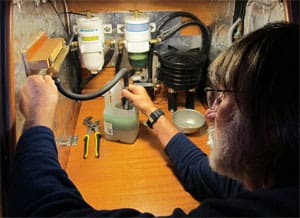Editor’s note: Voyagers can experience a wide disparity in fuel quality in various parts of the world. Here, cruising mechanical systems expert Nigel Calder reviews aspects of the current situation.
Not so many years ago, diesel fuel contained between 3 and 4 percent sulfur. One of the attributes of sulfur is its use as a lubricant. Since 2001, high-sulfur fuel has been more or less progressively legislated out of existence and replaced with ultra-low-sulfur diesel (ULSD), which is now being universally sold in developed countries. However, higher sulfur fuels are still available in some less-developed countries.
Most diesel engines will run fine on both as long as the fuel is clean, but some of the modern, electronically controlled engines with high-pressure injection systems (especially “common rail”) may not. Owners of these engines will need to be particularly careful when refueling in out-of-the-way parts of the world. High-sulfur fuels are also likely to damage catalytic converters on those engines that have this type of exhaust gas treatment system (similar to catalytic converters on cars, these are currently uncommon in the marine world but may become more common as emissions standards toughen). At the other end of the spectrum, engines built before 2001 may benefit from the addition of a fuel conditioner to ULSD fuel. This restores the lubricity formerly supplied by the sulfur.
Biodiesel
Of more general concern is the introduction of biodiesel into the fuel supply. Whereas petroleum-based diesel holds virtually no water (any water settles out and can be removed from the bottom of the tank), biodiesel can absorb and hold significant amounts of water, which may promote bacterial contamination. Water commonly enters tanks through poorly sited vent fittings, leaking deck fills and from condensation on the sides of partially empty metal tanks (changes in temperature cause humid marine air to move in and out of the tank through the vent fitting with moisture condensing out in the tank). The latter problem can be prevented by fitting a hygroscopic, or water-absorbing, filter in the vent line such as those from H2Out (www.H2Out.com).
Diesel biofuels are categorized as BXX where the “XX” represents the percent of biofuel. For example, B10 has 10 percent biofuel, while B100 is 100 percent biofuel. In general, so long as it is not contaminated, blends of up to 20 percent biofuel can be used safely in most diesel engines, although this may void engine warranties. In both the U.S. and Europe, various pieces of legislation are likely to result in increasing amounts of biofuel in diesel supplies (e.g., the Energy Policy Act of 2005 in the U.S., and the Renewable Transport Fuel Obligation in the U.K.). Various western navies are currently collaborating to develop a standardized specification for 100 percent biodiesel that they can all safely use in their ships.
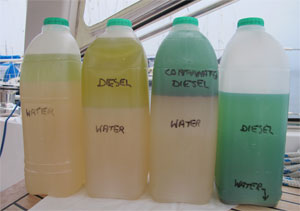 |
|
Calder’s boat took on the water shown here through a tank vent in the cabin side during a rough two-day passage from Norway to Scotland. If he hadn’t found it with his sampling pump, it would have overwhelmed the fuel filters and likely damaged the fuel injection system. |
Gasoline fuel supplies
Biofuels are a particular problem with marine gasoline engines, which may not seem relevant to those of us with diesel engines in our boats, but then most of us also have a gasoline-powered outboard motor.
The typical biofuel additive is ethanol, which is now required by law in some countries. As with other biofuels, ethanol absorbs moisture. As long as the ethanol remains in solution with the gasoline, the moisture gets burned off in the engine; but, if the moisture exceeds a certain level, phase separation occurs in which the moisture-saturated ethanol settles out in the bottom of the tank, giving off a cloudy appearance. It can cause substantial damage if drawn into an engine, in addition to exacerbating corrosion issues with metal tanks. The remaining gasoline, which would then float on top of the ethanol, becomes deoxygenated to a certain extent and is no longer suitable as a fuel, so even if the phase-separated ethanol is removed from the bottom of the tank, the fuel should not be used — i.e., the entire contents of the tank needs to be disposed of.
Ethanol-blended fuel should be used soon after purchase and should not be stored for extended periods of time in the humid marine environment. During layup periods, if possible, the outboard motor should be run until the tank and motor are dry. If this is not possible, the tank should be topped off in order to minimize the exposed tank area on which condensation will occur as changes in ambient temperature move air in and out of the tank (note that the U.S. National Fire Protection Association calls for tanks to be topped off, rather than left empty, in order to minimize explosive vapors). If stored fuel is to be left for a long period of time, a stabilizer (an antioxidant) should be added; note that this will not prevent phase separation. The bottom of the tank should be sampled before using the fuel.
Engine damage
Higher levels of ethanol (above 10 percent) raise combustion chamber temperatures in engines through increased oxygen. At wide open throttle, these higher temperatures can cause catastrophic damage to valves and other components and, ironically, result in higher emissions — the reduction of which is the principal reason for mandating the use of ethanol in the first place. If the fuel supply contains more than 10 percent ethanol, you are strongly advised not to run an outboard engine for any length of time at full throttle. Right now, 15 percent ethanol is finding its way into the U.S. marketplace, driven by the Renewable Fuel Standard passed by Congress in 2005; this act needs to be amended or repealed. This is damaging to all existing marine gasoline engines and many older vehicles. It should not be used in any boats or outboard motors.
Ethanol is also a solvent that will dissolve the resins out of some fiberglass tanks (which will then fail), the rubber out of some fuel hoses (pre-2009 hoses should be replaced; newer hoses have an inner liner that resists damage) and the gunk out of older engines, all of which then finds its way into the engine. If not caught by the filters, it can do expensive damage.
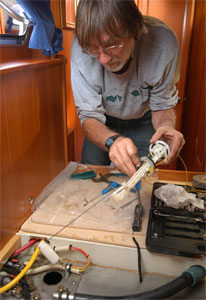 |
|
Calder removes the fuel tank level sender to access the tank to clean it out after taking on a foul batch of fuel. The sending unit should be marked before removal so it can be put back exactly the same way. |
Testing by the ABYC, Mercury Marine, Volvo Penta and others has demonstrated that isobutanol, a naturally occurring alcohol derived from fermenting a biomass, achieves the desired benefits of ethanol — principally, lowered emissions — without the negative consequences. In other words, there are alternatives to ethanol. The big problem in getting these accepted is the power of the farm lobby in Washington, which benefits from the fact that corn is used for most ethanol production in the U.S.
In December 2013, the U.S. Environmental Protection Agency (EPA) began backing away from mandating higher levels of ethanol as part of the Renewable Fuel Standard. On the other hand, in December 2014 the Chicago City Finance Committee voted to require all larger gas stations in the city to switch to E15 gasoline. It is to be hoped that over the next few years the legislatures of the world will find a way to meet targets with respect to fuel supplies without creating expensive headaches for boat owners.
Clean fuel
Regardless of the nature of the fuel supply, keeping it clean is arguably the single most important engine maintenance task on a boat. Biocides will help ameliorate some fuel problems after they develop, but by far the best measures are preventive — those that avoid taking on contaminated fuel in the first place, and those that detect and remove any contaminants taken on board rather than neutralize them. To do this:
• Ensure that all cans used for carrying fuel are spotlessly clean.
• If taking on fuel from a barrel, which happens from time to time in less-developed countries, first insert a length of small gauge clear plastic tubing to the bottom of the barrel, plug the outer end with a finger, and then withdraw the tube. It will bring up a sample of fuel from all levels of the barrel, enabling you to see serious contamination.
• Filter all fuel using a funnel with a fine mesh, or the Teflon-coated aircraft filters sold by marine chandlers that have now replaced, and are better than, the multistage “Baja” filters previously used by many cruisers. If there are any signs of contamination, stop refueling at once.
• Take regular samples from the bottom of the fuel tank to check for contamination. If there is no accessible drain valve, find some means of pumping out a fuel sample. At the first sign of contamination, drain the tank or pump out the fuel until no trace of contamination remains. Any especially dirty batch of fuel should be completely discarded — it’s not worth risking the engine for the sake of a tankful of fuel.
• On our own boats, and on all others with which I am involved in the design process, I always include a fuel-sampling pump that is permanently plumbed to the lowest point in the main fuel tank. You can use an electric pump available from most auto parts stores, or a manual pump (including the outboard motor style of fuel priming bulbs — the type you squeeze — as long as it is rated for diesel). This allows me to withdraw a fuel sample at any time and pump it into a see-through container, such as an old plastic milk jug or jam jar; all I need is one cup of fuel from the very bottom of the tank, and serious contamination is immediately apparent. This inexpensive measure will do more to protect your fuel system than anything else you can do. We have three times found serious contamination that we were able to remove before it did any damage, and the one season we didn’t use our sampling system we had our fuel system seriously fouled!
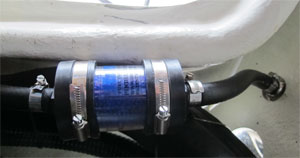 |
|
A fuel tank vent dessicating filter. |
• When leaving the boat unused for long periods (e.g., when it is laid up over the winter), fill the fuel tank to the top. This eliminates the air space and cuts down on condensation in the tank. Also add a biocide. Note that overfilling a tank risks fuel spills through the vent fitting, with potentially severe fines and cleanup costs. An environmental vent valve (EVV) from Clean Marine Systems, or similar devices from Perko and others, mounted where the vent line connects to the tank or back to the fill fitting, will prevent this (the valve has a ball that floats up and jams the vent if the tank is overfilled). When returning the boat to service and before you crank the engine, pump a fuel sample from the base of the tank to remove any condensates.
• Periodically flush the fuel tank(s) to remove accumulated sediment.
Fuel polishing
Fuel polishing is the process of circulating all the fuel in a tank through an external filter to remove contaminants. It will not be necessary if the above fuel-handling recommendations are followed. If done, it is a waste of time if it does not remove the contaminants that settle out in the bottom of a tank. To do this requires either a flushing action, which in turn requires high-volume pumps and filters, and high flow rates across the low spot of the tank, or it requires pumping all the fuel out into an external tank, down to the lowest spot in the tank and, in serious cases of contamination, flushing the tank to break loose contaminants adhered to tank surfaces.
The lubrication system
Lubricating oil in a diesel engine works much harder than in a gasoline engine, due to the higher temperatures and greater loads encountered. This is especially the case with today’s lightweight, high-speed, turbocharged diesels. Diesel engine oil also has additional problems to contend with, notably acid and soot formation.
Although it is a thoroughly destructive practice that should be avoided in every way possible, many cruising boat engines — particularly those in sailboats — are operated for short periods without properly warming up (e.g., when pulling out of a slip) and/or for long hours at light loads when charging batteries or refrigerating at anchor. The engine runs cool, which causes moisture to condense in the engine. These condensates combine with traces of sulfur to make sulfuric acid, which attacks engine surfaces. Low-load and cool running also generate far more carbon (soot) than normal. This soot gums up piston rings and coats valves and valve stems, leading to a loss of compression and other problems.
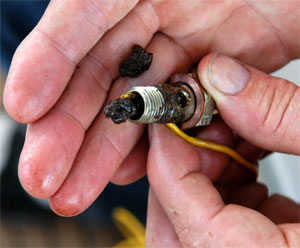 |
|
Gasoline fuels with high levels of ethanol can foul spark plugs. |
Diesel engine oils are specially formulated to hold soot in suspension and deal with acids and other harmful byproducts of the combustion process. Other additives reduce engine wear, raise the oxidation temperature of the oil, prevent foaming, help the oil adhere to metal surfaces when the engine is shut down, raise the oil’s viscosity when hot and lower its viscosity when cold. There is sophisticated chemistry in good engine oil!
The API “doughnut”
Using the correct oil in a diesel engine is vitally important. Many perfectly good oils designed for gasoline engines are not suitable for use in a diesel engine. The American Petroleum Institute (API) has developed its “doughnut” label, which is widely used around the world. At the top of the donut is the performance level of the oil. This uses the letter C (for Commercial, but I like to think of it as Compression ignition) to designate oils rated for use in diesel engines, and the letter S (for Service, but I like to think of it as Spark ignition) to designate oils rated for use in gasoline engines. You must use C-rated oil in a diesel engine (note that some oils are dual C and S rated; the critical thing is that there be a C rating). The C or S is then followed by another letter to indicate the complexity of the additive package in the oil, with the better packages having letters later in the alphabet. Thus any oil rated CH-4 (introduced in 1998), CI-4 (2002), or CJ-4 (2010) is suitable for use in modern high-speed diesel engines using ultra-low-sulfur diesel (ULSD), with the CJ-4 being the most recently introduced blend at the time of writing, and any designation with a letter before H being obsolete.
Ironically, these modern oils may be overspecified for many marine applications and in some circumstances can promote accelerated wear, especially with older engines operated at low speeds and loads much of the time. Various engine manuals still recommend obsolete oils (e.g., CD-rated), which may be available from the engine manufacturer. Note also that CJ-4 presumes the use of diesel fuels with less than 0.05 percent sulfur content (i.e., ULSD) and is actually designed for fuels with 0.0015 percent sulfur. If you’re going to a part of the world with higher sulfur fuels, more frequent oil changes or a different oil will be needed (e.g., CH-4 and CI-4 are formulated for up to 0.5 percent sulfur). If you cannot find the oil recommended by your engine manufacturer, it would be worth checking to determine an acceptable substitute. Cruisers going to less-developed countries should carry a good stock of suitable oil.
The center of the API doughnut contains the viscosity grade, which is a measure of the oil’s ability to flow at certain temperatures. A multigrade oil (e.g., SAE 15W-40) is designed to be thin enough to flow at cold temperatures and thick enough to perform satisfactorily at high temperatures. Requirements will vary from engine to engine, so consult the manual. If in doubt, SAE 30 oil is suitable for most marine purposes unless the boat sees service in particularly cold weather, in which case a multigrade oil should be used.
The lower part of the doughnut may contain additional information about the oil. In particular, for diesel engine oils a “Plus” indicates oil with an enhanced soot-handling capability.
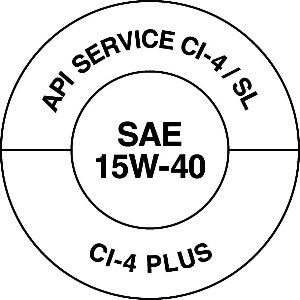 |
|
The API doughnut tells users the types of service for which the lubricating oil has been formulated. |
Synthetic oil
Synthetic oils are less volatile than mineral oils, which gives them greater high-temperature stability, reducing sludge formation and offering better protection in high-heat situations. They have higher film strength, so they tend to adhere better to bearing surfaces, improving their anti-wear characteristics. They also flow better at cold temperatures, resist oxidation and may improve fuel efficiency.
Synthetic oils are expensive, but they last much longer than mineral oil, in principle allowing oil-change intervals to be extended and thus recouping some of the additional cost. However, given the contaminants generated by marine diesels, I would not extend oil-change intervals without a recommendation from an engine maker. In the absence of such a recommendation, the added expense of synthetics is hard to justify. Additionally, if added to an older engine, particularly one that has been operated at low speeds, loads and temperatures (e.g., many sailboat engines), the added detergent properties of synthetic oils can break loose deposits, causing extensive damage. It is not advisable with older engines to change to synthetic oils.
Proprietary oils and filters
Manufacturers of larger common rail and high-pressure unit injection engines, which encompasses pretty much all new diesel engines over 100 hp these days, will frequently double oil change intervals if you use their proprietary oil. These oils are invariably expensive, but when taken in the context of the reduced maintenance and extended oil change interval, are well worth using as this also guarantees you get the correct oil for the engine. Once again, if voyaging “off the grid,” stock up on oil before setting sail.
On the subject of proprietary maintenance items, make sure you use the manufacturer’s filters. These are frequently far more expensive than identical-looking filters from the local autoparts store, but there may very well be small but important internal design changes. Since you don’t know whether or not this is the case, you should play it safe and buy the recommended filters.
Contributing editor Nigel Calder is the author of several books, including Boatowner’s Mechanical and Electrical Manual.

